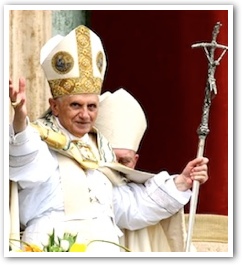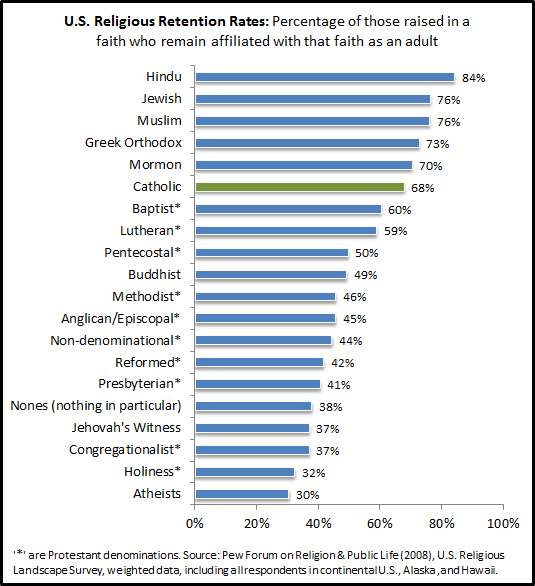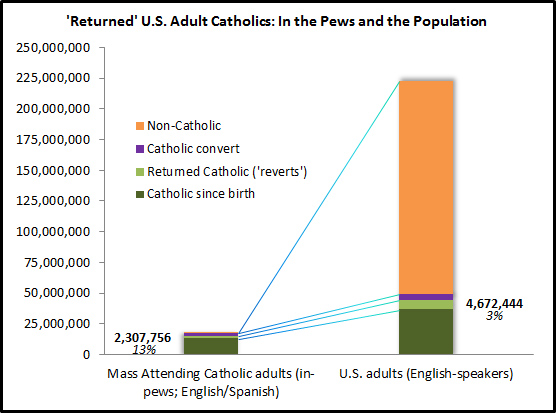The Reverts: Catholics who left and came back
- MARK M. GRAY
Almost 5 million current Catholics fell away, but then reverted. An analysis of who they are and why they came back.
 |
In a recent post, we noted that there are about 22.5 million people in the U.S. who were baptized and raised Catholic who no longer self-identify as Catholic (i.e., some join other faiths and others report having no religious affiliation and become "Nones"). This number is often quoted and very easy to come by using surveys that include a question about whether one is still a member of the faith that they were raised in. For any religion, the percentage of adults who remain affiliated is called the "retention rate."
See the figure below to comparatively evaluate how well the U.S. Catholic Church does in retaining its members (more on this here: 1, 2, 3). All things considered a 68% retention rate is better than many faiths achieve (...all Protestant denominations with sufficient numbers of respondents for an estimation have lower retention rates than the Catholic Church). And if you think it is challenging to be a Catholic parent try being an Atheist parent! Some 70% of Americans raised to believe God does not exist end up being a member of a religion as an adult (about one in five former Atheists drift off to become an open-minded agnostic or None).
 |
What is less often noted in the discussion of retention, and only very rarely reported on in the secular press (...with this exception by Cathy Lynn Grossman who inspired this post), is the number of people raised Catholic who left the faith but who later returned to the Church. These people are measured as "retained" in snapshot surveys because researchers so rarely ask about any of the time in between when the poll is being conducted and the respondent's recall of their childhood religion.
Those who leave and come back are often called the "returned" Catholics or the "reverts." CARA has two data sources that can be used to estimate the size of this population. The first is the responses of 20,031 in-pew surveys from adult Mass attenders in parishes across the country and the second is a national survey of 1,504 adults conducted last week. From these two sources we can estimate that in the pews, on a typically weekend, you can expect that about 13% of the adults in attendance are reverts, which is equivalent to 2.3 million people. These individuals are a part of a larger 4.7 million adults in the United States who self-identify as a returned or revert Catholic. However, this is a bit of an under-count as the survey on which this later number is based was only conducted in English. Using other CARA data sources and the in-pew responses (...where surveys were conducted in both English and Spanish) together we can estimate that there are likely an additional 360,000 Spanish-speaking reverts. Thus, in total CARA estimates there more than 5 million Catholic reverts nationally in 2012 (i.e., equivalent to 9% of all adult Catholics).
 |
In a previous post, we noted that the Catholic population could not maintain its approximate 25% U.S. population share by immigration alone as many argue (...given the Catholic retention rate and that only 2.6% of U.S. adults saying they converted to Catholicism as an adult). The math just does not work (...other important factors to complete this equation are the annual number of baptisms, Catholics leaving the U.S., and deaths of Catholics). Part of what is keeping the Catholic population percentage so steady is Catholic reverts. In a typical year, CARA estimates that there are approximately 168,000 people who were raised Catholic and left the faith (typically in their teens or early 20s) who come back.
Who are the Catholic reverts? Currently, these are people who are disproportionately between the ages of 25 and 34 (currently a combination of the oldest Millennials and the youngest of the Post-Vatican II Generation). A plurality of regular Mass attending Catholic reverts (41%) are of the Post-Vatican II Generation (ages 31 to 51). Another numerous group of reverts are in their retirement years (age 65 or older). Younger reverts may be coming back as they marry and raise childrenseeking out sacraments. Seniors may turn back to the faith of their youth just at the moment they begin to face the autumn of their life.
Among reverts who are regularly attending Mass (as measured in CARA in-pew surveys), 47% report that they had attended Catholic elementary school, 30% went to a Catholic high school, 89% celebrated the Sacrament of Confirmation, and 12% went to a Catholic college or university.
Those more interested in the life-cycle phenomenon of why and how Catholics revert should check out In the Course of a Lifetime: Tracing Religious Belief, Practice, and Change by Michele Dillon and Paul Wink. If you are not a numbers person and instead want to hear the stories of people who reverted back to the Catholic Church check out these profiles over at whyimcatholic.com. Finally, over at the USCCB here are some tips for how parishes can welcome back reverts.
Update/Note:Some of the retention rates in the figure above were never provided in Pew's original report. These are calculated from the original data sets released by Pew for this study (one for the continental U.S. and another for Alaska and Hawaii). In these data there are 432 weighted respondents who say they were raised as Atheists. A total of 131 of these individuals self-identify as an Atheist at the time of the survey resulting in an estimated retention rate of 30%. However, there were a total of 1,387 Atheists (weighted) identified in the survey (equivalent to 1.6% of the adult population). What these findings reflect is that in the U.S. Atheists are for the most part "made" as adults after being raised in another faith. It appears to be much more challenging to raise one's child as an Atheist and have them maintain this identity in their life. Of those raised as Atheists, 30% are now affiliated with a Protestant denomination, 10% are Catholic, 2% are Jewish, 1% are Mormon, and 1% are Pagan.
Some also seem to want to treat (as Pew does in its original report) switching between Protestant denominations as a non-switch. It is true that all of these respondents are still practicing Christianity (as are those who leave Catholicism for a Protestant denomination or for the Greek Orthodox Church) but in terms of the effect on the religious organization and the individual a real change in membership has occurred. I don't think the Presbyterians are just fine with losing 59% of those raised in the faith as long as these former members are in another Protestant denomination's church. From an organizational perspective I assume all of these religious institutions would prefer to maintain their youthful members in a similar regard (...with the exception of Atheists who have no real institution or organizational structure... which may have something to do with the very low retention rate for this group).
 This is Meaghen Gonzalez, Editor of CERC. I hope you appreciated this piece. We curate these articles especially for believers like you.
This is Meaghen Gonzalez, Editor of CERC. I hope you appreciated this piece. We curate these articles especially for believers like you.
Please show your appreciation by making a $3 donation. CERC is entirely reader supported.

Acknowledgement
Mark M. Gray. "The Reverts: Catholics who left and came back." Nineteen Sixty-four (June 19, 2012).
Nineteen Sixty-four is a research blog for the Center for Applied Research in the Apostolate (CARA) at Georgetown University edited by Mark M. Gray. This article is reprinted with permission from the Mark M. Gray.
CARA is a non-profit research center that conducts social scientific studies about the Catholic Church. Founded in 1964, CARA has three major dimensions to its mission: to increase the Catholic Church's self understanding; to serve the applied research needs of Church decision-makers; and to advance scholarly research on religion, particularly Catholicism. Follow CARA on Twitter at: caracatholic.
The Author
Mark M. Gray is the Director of CARA Catholic Polls and a Research Associate at CARA. He has a Ph.D. in Political Science and a M.A. in Social Sciences from the University of California, Irvine.
Methodologically, Mark specializes in survey research, trend analysis, and cross-sectional time-series studies. Some of his recent work at CARA has included national surveys of adult Catholics, surveys for Catholic schools, diocesan-level trend analyses, program evaluations, and Catholic media studies. Academically his research focuses on political culture, political participation, and religion and politics. He has taught courses on Introduction to the Social Sciences, Introduction to Political Science, Societal Issues, and Latino/a Culture in the United States.
Copyright © 2012 Center for Applied Research in the Apostolate



